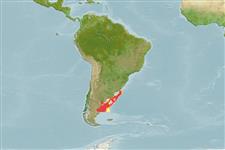Actinopterigi (pesci con pinne raggiate) >
Pleuronectiformes (Flatfishes) >
Paralichthyidae (Large-tooth flounders)
Etymology: Paralichthys: Greek, para = the side of + Greek, ichthys = fish + Greek, suffix, oides = similar to (Ref. 45335). More on author: Jordan.
Ambiente / Clima / Range
Ecologia
; marino demersale; distribuzione batimetrica 50 - 190 m (Ref. 36453), usually 70 - 100 m (Ref. 43588). Subtropical, preferred ?; 34°S - 47°S
Southwest Atlantic: Brazil to Argentina.
Size / Peso / Age
Maturity: Lm ? range ? - ? cm
Max length : 32.0 cm TL maschio/sesso non determinato; (Ref. 43588); 38.0 cm TL (female)
Short description
Morfologia | Morfometria
Spine dorsali (totale): 0; Raggi dorsali molli (totale): 79-92; Spine anali 0; Raggi anali molli: 65 - 72; Vertebre: 38 - 39. Caudal fin double truncate (Ref. 27363). Almost wholly ambicolorate, the blind side is darkly pigmented except for the anterior portion of the body which has dark pigments only on the opercle, subopercle, a small region adjacent and dorsal to the head, and the distal half of the pectoral fin; two lighter pigmented areas were present on the unpigmented dorsal region of the head. The blind side had one of the 3 typical ocelli (upper one) in the same position with that of the ocular side (Ref. 34245).
Prefers hard or sandy substrates, rarely on mud (Ref. 43588). Feeds on fishes and cephalopods (Ref. 36453).
Life cycle and mating behavior
Maturità | Riproduzione | Deposizione | Uova | Fecundity | Larve
Distinct pairing (Ref. 205).
Nakamura, I., T. Inada, M. Takeda and H. Hatanaka, 1986. Important fishes trawled off Patagonia. Japan Marine Fishery Resource Research Center, Tokyo. 369 p. (Ref. 27363)
IUCN Red List Status (Ref. 115185)
CITES (Ref. 94142)
Not Evaluated
Threat to humans
Harmless
Human uses
Informazioni ulteriori
BibliografiaAcquacolturaProfilo di acquacolturaVarietàGeneticaFrequenze allelicheEreditarietàMalattieElaborazioneMass conversion
CollaboratoriImmaginiStamps, CoinsSuoniCiguateraVelocitàModalità di nuotoArea branchialeOtolithsCervelliVista
Strumenti
Special reports
Download XML
Fonti Internet
